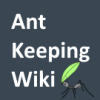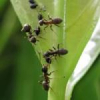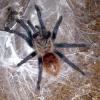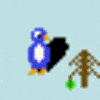I figured it's about time I try a journal.
The first pictures I have are from back in October 2017. My ant photography start off terrible, but eventually are just okay. So forgive my early pic quality. It get's slightly better. I promise.
Here is my first picture of them. I had a whopping 9 workers. You can see their pile of pupae, placed closest to the heat. Those seeds are nyjer seeds. I highly recommend nyjer seeds for larger species of harvesters.

By the end of October, a few more workers eclosed. Look at how clean their nest area is! Big thanks to Drew for the founding formicarium, it worked really well.

Here they are in March - also it gives you a birds eye view of their whole setup. As they grew bigger they moved their seed pile to their outworld. Their chaff pile is to the right. I forgot how small that used to be! The tin foil is in contact with some heating elements. That's why they've moved their pupae outside the nest. That big white blob in their nest (upper right hand corner) is a piece of pine nut. I was still trying new foods out at this point. In early March they had just over 20 workers. Pretty slow growth, but their population was about to take off.

As I mentioned before, I feed these gals nyjer seeds which they seem to love. Here they are munching on a cricket!

Mid March, and I notice they have an absolute ton of pupae. Finally some faster growth! Also, notice how gross their nest started getting - it was around this time when I decided I'd have to build them a new formicarium.


I built a new formicarium! I'll upload the build process probably in it's own thread, but I'll link to it from here when I finish my build journal. If there is interest. Here they are right before moving! This was still in march. Crazy how many pupae hatched in one month.

I really wasn't diligent in taking photos - so here are photos from August.
Front of the formicarium! I labeled all the chambers that are utilized - I originally had other chambers blocked off with cotton, but of course the ants just chewed through it. In my 2nd gen formicarium I'll have to solve this. I used riverbed clay for the mold, and obviously I failed to get all the clay out - which is why they've stacked clay against the glass. My original heating cable design left lots of condensation, and that's where the ants stacked the clay.

Top view of the formicarium. As you can see, I really need to clean the chaff pile. Anyone have a good way of doing this? I usually use forceps but it always takes forever.

Here is a look inside chamber 1. This chamber isn't heavily utilized - it's a bit cooler, so they sometimes being their pupae in from chamber 2 when chamber 2 gets too hot (sorry ants! but at least I have places where they can flee from the heat). They sometimes being larger larvae in here, and you can see a few dark pupae about to pupate.

Here is a look inside chamber 2! This is the hottest chamber, and it utilized mainly for storing pupae. These harvesters keep their pupae very hot - I'll stick a temp probe at some point but I'd guess its around 95-100 F right now. I keep the heating coil on an adjustable plug so I can raise/lower the temp. I can tell it's starting to get too hot when they start moving their pupae away from the glass.

Here is a view slightly further into CH2. They keep their larger larvae towards the back where it is cooler. I'm still trying to figure out the lighting situation for pictures. Also, you can pretty clearly see some shelled nyjer seeds. They often keep shelled seeds handy.

CH3 is their granary.


No more editing on the main post - to read more, please find my post here!
Edited by JasonD, September 15 2017 - 7:54 PM.

































